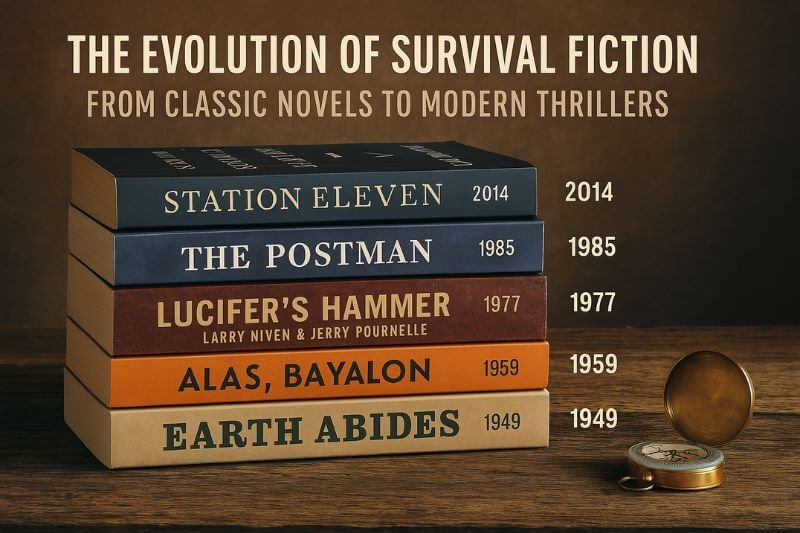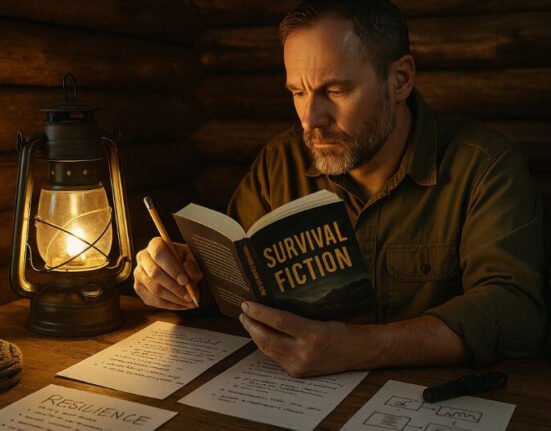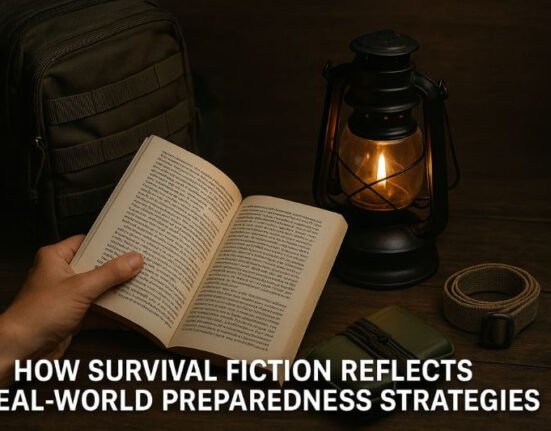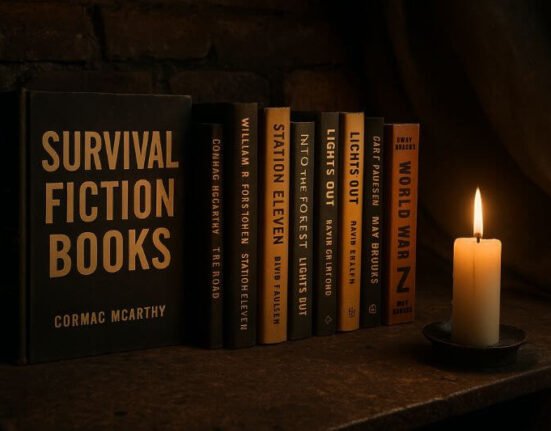The evolution of survival fiction is more than just a literary trend — it’s a window into how societies react to existential threats over time. From the radioactive dread of Cold War-era novels to today’s post-pandemic psychological thrillers, the way we write and consume survival fiction reveals how we’ve learned — or failed — to prepare for collapse.
This genre is not static. It mutates with our anxieties, mirrors our technologies, and shifts with each new global event. Whether it’s a lone boy in the woods, a nuclear family in an underground bunker, or a biotech-fueled dystopia, survival fiction constantly reinvents itself — and us with it.
To understand how we think about survival today, we must look at where these stories began.
🕰️ Chapter One – The Origins: Fear of Total War and Annihilation
Survival fiction, as a modern genre, truly took shape in the mid-20th century, when the world grappled with the tangible threat of nuclear war and geopolitical collapse.
🔎 “Earth Abides” by George R. Stewart (1949)
- Premise: A mysterious pandemic wipes out most of humanity.
- Significance: One of the earliest post-collapse novels with a deep anthropological and ecological lens.
- Impact: Inspired generations of “quiet collapse” fiction — where rebuilding, not action, is central.
🔎 “Alas, Babylon” by Pat Frank (1959)
- Premise: A Soviet nuclear strike decimates the U.S., forcing a Florida town to survive on its own.
- Significance: One of the first American survival fiction bestsellers.
- Prepper Value: Detailed portrayal of bartering, water purification, medical shortages — long before prepping was mainstream.
🔎 “On the Beach” by Nevil Shute (1957)
- Premise: After a nuclear war, the last survivors wait for the radiation cloud to reach them in Australia.
- Tone: Bleak. Inevitable doom. No weapons, just reflection.
- Takeaway: Survival fiction didn’t always mean surviving. Sometimes, it meant facing the end with clarity.
💡 What these classics have in common:
- They reflect a Cold War mindset: binary threats, visible enemies, looming apocalypse.
- They assume collapse is external — dropped from the sky, not grown from within.
- They explore resilience through moral character and social order, not yet tactical skills or gear.
🔄 From Cold War to Chaos: The Shift Toward Tactical Survival (1980–2000)
As the Cold War faded, survival fiction evolved from geopolitical dread into more tactical, individual-focused scenarios. The 1980s and 1990s saw a shift: threats were no longer just nuclear — they became economic, social, environmental, and internal.
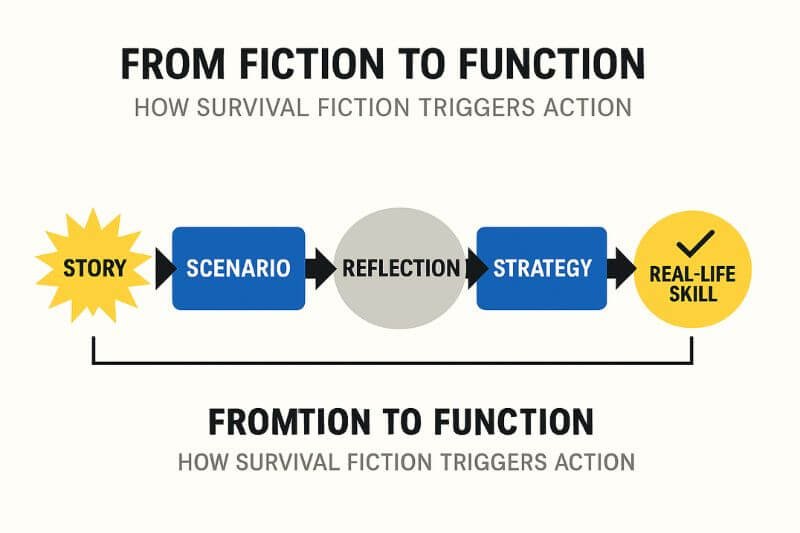
🔎 “Lucifer’s Hammer” by Larry Niven & Jerry Pournelle (1977)
- Premise: A comet strikes Earth, triggering global catastrophe.
- Legacy: A landmark novel that blends hard science with community survival.
- Prepper Insight: Agricultural collapse, civil disorder, technical skills to rebuild civilization.
🔎 “The Postman” by David Brin (1985)
- Premise: In a fragmented post-apocalyptic America, a drifter inspires hope by pretending to be a postal worker of a restored government.
- Theme: Hope, identity, rebuilding society through symbols rather than brute force.
- Reflection: Not every survival story is about fighting — some are about restoring meaning.
🔎 “Patriots” by James Wesley Rawles (1998)
- Premise: A group of preppers survive an economic collapse using well-planned bug-out strategies.
- Impact: Hugely influential among the modern prepper movement.
- Details: Realistic gear lists, defense tactics, financial collapse modeling.
✅ First “manual-style” fiction book that blurs the line between story and how-to guide.
⚠️ The Rise of the “Prepper Novel”
Starting in the late 1990s and early 2000s, fiction began to target readers who were also preppers — not just thrill-seekers. These novels focus on logistics, homesteading, EMPs, off-grid defense, and strategic planning.
What changed:
- Threats became more complex: cyberattacks, EMPs, pandemics.
- Protagonists became trained and aware, not just victims or bystanders.
- Gear, guns, and grids replaced metaphors and moral debates.
This reflects a cultural shift: readers weren’t looking for what it feels like to survive — they wanted to see how to do it.
📊 Timeline Snapshot – Thematic Shift in Survival Fiction
| Period | Dominant Threat | Hero Archetype | Core Message |
|---|---|---|---|
| 1950–1970 | Nuclear war | Moral leader | Accept fate or uphold virtue |
| 1980–1995 | Natural disaster, chaos | Opportunist or reformer | Rebuild with grit and vision |
| 1995–2005 | Economic/social collapse | Tactical prepper | Prepare or perish |
🌍 Survival Fiction Today – Realism, Psychology, and Uncertain Futures
Since the 2010s, survival fiction has entered a new phase: hyper-realistic, psychologically complex, and socially self-aware. The genre now reflects our world of pandemics, misinformation, algorithmic control, climate anxiety, and fractured trust.
🔎 “Station Eleven” by Emily St. John Mandel (2014)
- Premise: A pandemic collapses the world. Years later, a traveling theater troupe tries to keep art and memory alive.
- Tone: Quiet, emotional, nonlinear.
- Theme: What do we preserve when society ends?
- Survival Insight: Psychological adaptation, grief, cultural continuity.
🔎 “Blackout” by Marc Elsberg (2012)
- Premise: A cyberattack on Europe’s power grid leads to total collapse.
- Prepper Value: Urban collapse, energy dependency, systemic failure.
- Trend: Fiction influenced by real tech risk assessments.
🔎 “Leave the World Behind” by Rumaan Alam (2020)
- Premise: A family vacation is interrupted by an unexplained disaster.
- Style: Ambiguous, emotional, claustrophobic.
- Lesson: You won’t always know what’s going on — you just have to act.
🔎 Self-Published Survival Thrillers (Post-2020)
The rise of Kindle Direct Publishing has flooded the genre with:
- EMP scenarios
- Pandemic thrillers
- Climate fiction (“cli-fi”)
- Domestic prepping dramas
These books often reflect real fears and practical tactics, written by preppers for preppers.
🧠 What This Evolution Tells Us
The evolution of survival fiction mirrors our global anxieties:
- From external enemies → to internal collapse
- From bombs → to bugs (viruses, cyber-attacks)
- From simple survival → to complex resilience
Fiction now asks:
“Can we preserve not just life — but meaning, memory, identity?”
And in doing so, it prepares our minds for futures we can’t predict.
Read the Evolution, Build the Resilience
📘 Want to prep your brain, not just your bug-out bag?
Start reading across eras:
- Alas, Babylon (Cold War ethics)
- Lucifer’s Hammer (collapse logistics)
- Station Eleven (post-pandemic psychology)
🧠 Then dive into our guides to apply fiction to your prepping:
➡️ Survival Mindset & Resilience
➡️ Off-Grid Power Mistakes
➡️ Bug Out Strategy
Because preparation starts in your imagination.
❓ Frequently Asked Questions (FAQ)
Q: Is survival fiction still relevant today?
More than ever. With real-world crises increasing, fiction offers low-risk mental rehearsal for complex emergencies.
Q: What is the most realistic modern survival novel?
Probably One Second After for EMP scenarios, or Blackout for urban collapse. But Station Eleven is unmatched in emotional realism.
Q: How can I use survival fiction in actual prepping?
- Extract key scenarios (EMP, pandemic, nuclear, societal collapse).
- Analyze character decisions.
- Reflect on what skills or gear you would need.
- Adapt lessons to your environment.
Q: Has survival fiction changed due to COVID-19?
Yes — post-2020 fiction includes more psychological depth, uncertainty, and themes of information overload, media distrust, and digital collapse.
Q: What makes a survival fiction story timeless?
It’s not the gadgets. It’s the emotional truth: fear, hope, loyalty, choices.
That’s what sticks — and what preps the mind for reality.









